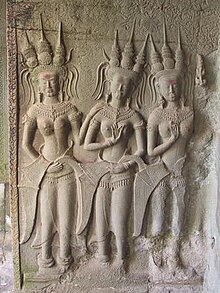| Revision as of 04:01, 26 May 2004 edit62.248.39.230 (talk)No edit summary← Previous edit | Revision as of 15:52, 12 June 2004 edit undoAhoerstemeier (talk | contribs)110,683 editsm +de:Next edit → | ||
| Line 5: | Line 5: | ||
| The Apsara were very beautiful and sometimes lured men to their deaths. | The Apsara were very beautiful and sometimes lured men to their deaths. | ||
| Apsaras are often depicted in ] art as far afield as ] and ], however. | Apsaras are often depicted in ] art as far afield as ] and ], however. | ||
| Line 11: | Line 10: | ||
| ] | ] | ||
| {{ |
{{stub}} | ||
| ] | |||
Revision as of 15:52, 12 June 2004

In Hinduism, the Apsaras (also Vrikshakas) are nature spirits, all the female wives of the Gandharvas. They danced to the music made by their husbands, usually in the various gods' palaces.
The Apsara was associated with fertility rites.
The Apsara were very beautiful and sometimes lured men to their deaths.
Apsaras are often depicted in Buddhist art as far afield as Cambodia and China, however.

This article is a stub. You can help Misplaced Pages by expanding it. |